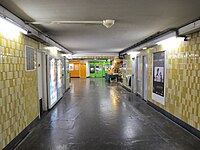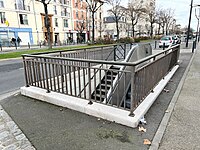Maisons-Alfort–Stade station
| Paris Métro station | |||||||||||
 MF 77 at Maisons-Alfort–Stade | |||||||||||
| General information | |||||||||||
| Location | Maisons-Alfort Île-de-France France | ||||||||||
| Coordinates | 48°48′31″N 2°26′10″E / 48.808681°N 2.436073°E | ||||||||||
| Owned by | RATP | ||||||||||
| Operated by | RATP | ||||||||||
| Line(s) | |||||||||||
| Platforms | 2 (2 side platforms) | ||||||||||
| Tracks | 2 | ||||||||||
| Construction | |||||||||||
| Accessible | no | ||||||||||
| Other information | |||||||||||
| Station code | 2515 | ||||||||||
| Fare zone | 3 | ||||||||||
| History | |||||||||||
| Opened | 19 September 1970 | ||||||||||
| Passengers | |||||||||||
| 1,702,479 (2021) | |||||||||||
| Services | |||||||||||
| |||||||||||
| |||||||||||
Maisons-Alfort–Stade (French pronunciation: [mɛzɔ̃ alfɔʁ stad]) is a station on line 8 of the Paris Métro in the commune of Maisons-Alfort. It is named after the commune the station is situated in, as well as the nearby Stade Auguste Delaune.
History[edit]
The station opened on 19 September 1970 as part of the extension of the line from Charenton–Écoles, serving as its eastern terminus until it was further extended to Maisons-Alfort–Les Juilliottes on 27 April 1972. This began a new wave of network expansions after a 18-year break due to limited financial resources during the post-war period. It marks the first appearance of "box stations", characterised by its rectangular shape due its cut-and-cover method of construction.
In 2019, the station was used by 2,330,375 passengers, making it the 221st busiest of the Métro network out of 302 stations.[1]
In 2020, the station was used by 1,393,467 passengers amidst the COVID-19 pandemic, making it the 186th busiest of the Métro network out of 304 stations.[2]
In 2021, the station was used by 1,702,479 passengers, making it the 208th busiest of the Métro network out of 304 stations.[3]
Passenger services[edit]
Access[edit]
The station has 2 accesses:
- Access 1: avenue du Général Leclerc côté des numéros impairs
- Access 2: avenue du Général Leclerc côté des numéros pairs (with an ascending escalator)
Station layout[edit]
| Street Level | ||
| B1 | Mezzanine | |
| Platform level | Side platform, doors will open on the right | |
| Westbound | ← | |
| Eastbound | | |
| Side platform, doors will open on the right | ||
Platforms[edit]
The station has a standard configuration with 2 tracks surrounded by 2 side platforms. Built in the 1970s, it is a cage station with vertical walls and a horizontal ceiling due to its cut-and-cover construction. The decoration, typical of this decade, is similar to a variation of the Mouton-Duvernet style with walls and tunnel exits covered with hollow patterned tiles in various shades of ochre, placed vertically and aligned, as well as a ceiling and wall tops treated in white. Lighting is provided by two suspended canopies that can also be found at the next station, École Vétérinaire de Maisons-Alfort, as well as at the Porte de Bagnolet station on line 3 (in addition, the Gambetta station on the latter line was equipped with the same model of canopy until its renovation in 2007). The advertising frames, slightly recessed in the walls, are metal and the name of the station is inscribed in Parisine font on enamelled plaques. The seats are Motte style in red.
The station shares this decorative style only with the two framing stopping points, École Vétérinaire de Maisons-Alfort and Maisons-Alfort-Les Juiliottes. However, ochre-coloured tiles also exist in the access corridors to the platform of the Créteil-Université station on the same line, except that they only have the lightest shade.
Other connections[edit]
The station is also served by lines 104 and 372 of the RATP bus network, and at night, by line N35 of the Noctilien bus network.
Nearby[edit]
- Cimetière de Maisons-Alfort
- Collège Edouard Herriot
- Fort de Charenton
- Stade Auguste Delaune
Gallery[edit]
-
Ticket barriers at the mezzanine
-
Corridors
-
Access 1
-
Access 2
-
Escalator at access 2
References[edit]
- ^ "Trafic annuel entrant par station du réseau ferré 2019". dataratp2.opendatasoft.com (in French). Archived from the original on 21 January 2022. Retrieved 4 November 2023.
- ^ "Trafic annuel entrant par station du réseau ferré 2020". data.ratp.fr (in French). Archived from the original on 21 January 2022. Retrieved 4 November 2023.
- ^ "Trafic annuel entrant par station du réseau ferré 2021". data.ratp.fr (in French). Archived from the original on 6 April 2023. Retrieved 4 November 2023.






